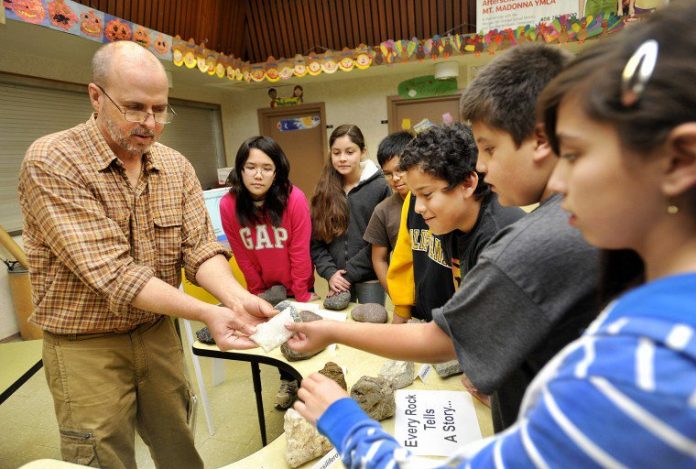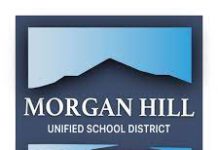San Martin/Gwinn Elementary students felt multiple 8.0 magnitude earthquakes Tuesday morning.
“It was scary,” said Paige Brill, 11, a sixth-grader.
But this wasn’t a typical California shaker; it was in fact, “The Big Shaker” an earthquake simulator brought on campus by the company QuakeHold! Industrial.
On campus for several hours Tuesday, the Big Shaker simulates earthquakes from a 2.0 magnitude equivalent on the Richter scale to an 8.0. On a truck trailer, the simulator shakes on hydraulics for five or more seconds, rocking the van back and forth violently as objects come flying off the shelves, then suddenly, it’s over.
“It was kind of a shock,” said sixth-grader Morgan Peterson, 11, who said she has felt small quakes before.
Inside the simulator, the worlds largest and one of five in California, is a comfortably staged living room that fits about eight people. A couch faces a TV with newsreels from real earthquakes and above on a shelf are books, stuffed animals and plastic bottles. Another TV to the right is inside another shelving unit. In a real earthquake, these items including the couple hundred pound shelves, could fall and hurt someone warns Taylor Reese, a sales and marketing representative from QuakeHold!
“So what we do is take kids through the earthquake,” said Reese. “A lot of them haven’t actually felt an earthquake before in their lives.”
Reese explains that the shelving units and TVs are strapped down with secure products by QuakeHold!. They’ve been through hundreds of simulated earthquakes and do not fall or move.
“It’s on the extreme end and it’s a shock, but by doing something like this, it’s a better opportunity because people can actually feel it, understand it and experience the reality of it,” said Reese.
Comparatively, the 8.0 magnitude five-second earthquake that students felt is higher than the Bay Area’s Loma Prieta earthquake in 1989, which was a magnitude 6.9 and killed more than 60 people causing a total $10 billion in structural damage and other losses. The infamous “Great San Francisco earthquake” of 1906 was a 7.8 that ruptured the San Andreas fault. Last year’s March earthquake in Japan was a registered magnitude 8.9, with many aftershocks. The initial quake triggered a tsunami that resulted in a nuclear power plant crisis at Fukushima and took about 19,300 lives.
According to the United States Geological Survey, there is a 62 percent probability for at least one magnitude 6.7 or greater quake between 2003 to 2032 to occur in the San Francisco Bay Area.
Drop, cover and hold on
Students from third through sixth grades took a ride in the Big Shaker while inside the school, earthquake educational stations were set up by volunteers from the USGS.
Karl Gross, a USGS volunteer, demonstrated to students what happens when pressure builds between the Pacific tectonic plate and the North American plate, representing the Hayward fault line which runs from south San Jose to the San Pablo Bay near San Rafael. The device, two wooden pieces side by side with a piece of tape in the middle moves one piece north with a crank, to demonstrate how pressure builds between two rock plates.
“As the pressure builds, the Pacific plate moves north, pressure builds along the fault. And we start to see little tiny faults along the line,” said Gross. These tiny faults are the cracks in sidewalks or along driveways that one sees in neighborhoods such as in Hollister, he said.
Finally, the piece of tape rips apart as it can no longer handle the pressure of the two plate moving, causing an earthquake, explained Gross.
At another station, geologist Phil Stoffer of the Geozeum in Hollister showed students how rocks are formed, bringing along examples of molten lava, basalt, quartz, or marble. Most of the examples Stoffer had collected the day prior in the region.
“It smells like the ocean,” said Ashley Lopez, 12, holding up an example rock.
Vicki Flagg, who works for the USGS and has her two daughters Cara and Ellie Fischer, both 11, at San Martin/Gwinn, helped set up these earthquake days for the school for the past four years. Since California is known as earthquake country, the USGS advocates for the “ShakeOut” an annual event in the Bay Area every third Thursday in October to prepare California residents.
“It’s a great educational tool, what to do, how to prepare for an earthquake,” she said.
Participants can learn about the basics of “Drop, cover and hold on” during an earthquake and run practice drills to be prepared for the big one.
“The bottom line is education,” said Reese.








